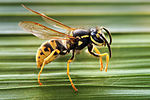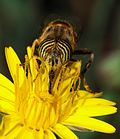Pollen wasps, the Masarinae, are unusual wasps that are typically treated as a subfamily of Vespidae, but have in the past sometimes been recognized as...
3 KB (289 words) - 20:15, 15 December 2023
pollen storage (pollen basket) as some bees do, pollen does not stick to them well. However it has been shown that even without hairs, several wasp species...
63 KB (6,795 words) - 17:29, 19 July 2024
pollen as they do. They then fly to another tree of the same species, where they deposit their eggs and allow the cycle to begin again. The fig–wasp mutualism...
20 KB (1,961 words) - 21:42, 17 July 2024
Wasps in the family Pompilidae are commonly called spider wasps, spider-hunting wasps, or pompilid wasps. The family is cosmopolitan, with some 5,000 species...
25 KB (2,825 words) - 14:09, 25 July 2024
Gall wasps, also traditionally called gallflies, are hymenopterans of the family Cynipidae in the wasp superfamily Cynipoidea. Their common name comes...
13 KB (1,246 words) - 06:14, 7 June 2024
jewel wasp, gold wasp, emerald wasp, ruby wasp and so on (cf. French guêpe de feu, "fire-wasp", and German / Dutch Goldwespe / goudwesp, "gold-wasp"). Members...
7 KB (725 words) - 00:05, 18 November 2023
Vespidae (redirect from Vespid wasp)
S2CID 85737989. Sühs, R.B.; Somavilla, A.; Putzke, J.; Köhler, A. (2009). "Pollen vector wasps (Hymenoptera, Vespidae) of Schinus terebinthifolius Raddi (Anacardiaceae)...
6 KB (634 words) - 21:18, 15 July 2024
with pollen when they were fed to the wasp larvae. This same evolutionary scenario may have occurred within the vespoid wasps, where the pollen wasps evolved...
118 KB (12,217 words) - 05:34, 29 July 2024
solitary potter wasps, that are classical examples of hunting wasps of the kind that build their nests out of mud. The Masarinae or pollen wasps are the major...
10 KB (1,401 words) - 15:38, 31 July 2024
Monobia quadridens (redirect from Four-toothed mason wasp)
and Tortricidae. The diet also includes a large proportion of pollen. Like many wasps, M. quadridens is capable of delivering a sting. The pain caused...
6 KB (631 words) - 15:00, 11 August 2024
Aculeata (redirect from Stinging wasps)
Michael S. (2019-11-07). "Direct evidence for eudicot pollen-feeding in a Cretaceous stinging wasp (Angiospermae; Hymenoptera, Aculeata) preserved in Burmese...
6 KB (436 words) - 23:46, 16 May 2024
Brachygastra – Genus of wasps (honey wasps) known to collect and store nectar as honey Pollen wasp – Subfamily of wasps unique among wasps in feeding their larvae...
99 KB (11,668 words) - 12:15, 17 August 2024
Evaniidae (redirect from Ensign wasp)
is a family of parasitoid wasps also known as ensign wasps, nightshade wasps, hatchet wasps, or cockroach egg parasitoid wasps. They number around 20 extant...
13 KB (1,238 words) - 09:21, 22 June 2023
Hymenoptera (redirect from Black wasp)
pollen, foliage, or stems. Stinging wasps are predators, and will provision their larvae with immobilised prey, while bees feed on nectar and pollen....
28 KB (2,803 words) - 22:17, 4 July 2024
Sphecidae (redirect from Thread-waisted wasp)
a cosmopolitan family of wasps of the suborder Apocrita that includes sand wasps, mud daubers, and other thread-waisted wasps. The name Sphecidae was formerly...
9 KB (672 words) - 06:46, 22 May 2024
Vespidae (paper wasps, potter wasps, hornets, pollen wasps, yellowjackets) Proctotrupomorpha Superfamily Chalcidoidea Family Agaonidae (fig wasps) Family Aphelinidae...
14 KB (1,133 words) - 14:48, 15 August 2024
Horntail (redirect from Horntail wasp)
Horntail or wood wasp are any of the 150 non-social species of the hymenopteran family Siricidae, a type of wood-eating sawfly. The common name "horntail"...
13 KB (1,422 words) - 08:15, 1 August 2024
Ichneumonoidea (redirect from Ichneumon Wasp)
species, many of which have not yet been described. Like other parasitoid wasps, they were long placed in the "Parasitica", variously considered as an infraorder...
9 KB (903 words) - 03:13, 21 January 2024
confuse common wasps and bees at a distance or without close observation, there are many different characteristics of large bees and wasps that can be used...
9 KB (579 words) - 08:14, 12 August 2024
Ichneumonidae (redirect from Scorpion wasp)
Ichneumonidae, also known as ichneumon wasps, ichneumonid wasps, ichneumonids, or Darwin wasps, are a family of parasitoid wasps of the insect order Hymenoptera...
33 KB (3,451 words) - 03:46, 2 July 2024
Hornet (redirect from Vespa (wasp))
Hornets (insects in the genus Vespa) are the largest of the eusocial wasps, and are similar in appearance to yellowjackets, their close relatives. Some...
26 KB (3,005 words) - 02:45, 10 July 2024
Fairyfly (redirect from Fairy wasp)
The Mymaridae, commonly known as fairyflies or fairy wasps, are a family of chalcidoid wasps found in temperate, subtropical, and tropical regions throughout...
55 KB (5,578 words) - 12:08, 14 August 2024
Pollination (redirect from Pollenation)
Pollination is the transfer of pollen from an anther of a plant to the stigma of a plant, later enabling fertilisation and the production of seeds. Pollinating...
73 KB (8,988 words) - 16:56, 6 August 2024
classifications to be a specialized lineage of "crabronid" wasps that switched to the use of pollen and nectar as larval food, rather than insect prey; this...
8 KB (547 words) - 21:58, 21 March 2024
Chalcid wasps (/ˈkælsɪd/, from Greek khalkos 'copper', for their metallic colour) are insects within the superfamily Chalcidoidea, part of the order Hymenoptera...
13 KB (1,266 words) - 08:00, 6 August 2024
Pelecinus (redirect from Pelecinid wasp)
Michael S. Engel; David A. Grimaldi (June 2006). "A Diminutive Pelecinid Wasp in Cretaceous Amber from New Jersey (Hymenoptera: Pelecinidae)". Northeastern...
1 KB (160 words) - 05:35, 6 January 2024
though a few nest in wood. They mass-provision their young; a mass of pollen and nectar is formed inside a waterproof cell, an egg laid upon it, and...
18 KB (1,635 words) - 07:07, 13 August 2024
bees are predatory aculeate wasps (especially Crabronidae, Sphecidae, Vespidae, and Pompilidae). The term "pollen wasps", in particular, is widely applied...
49 KB (5,591 words) - 06:46, 4 July 2024
The Mutillidae are a family of more than 7,000 species of wasps whose wingless females resemble large, hairy ants. Their common name velvet ant refers...
20 KB (2,233 words) - 11:32, 4 July 2024





























